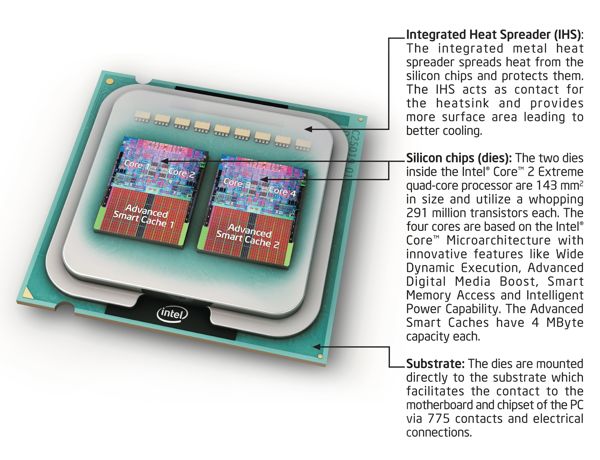Intel Core 2 Extreme QX6850: first impressions

Author:
Date: 16.07.2007 |
|
So, here comes the time we raise the standards in the Intel's CPU sector. Today, we are introducing a review of Intel's new quad-core CPU of the "extreme" series - Intel Core 2 Extreme QX6850, reporting its capabilities and briefly the test results, as well as reminding the forthcoming updates in Intel's CPU line.

The Extreme series processors can hardly be referred to as belonging to the mass category – even after some time once they appear on sales, their prices are reluctant to go down, and by that time something new of comparable specifications comes up which is much cheaper. Primarily, the goal of releasing Extreme chips is to demonstrate the power that Intel's technologies have attained, provide the opportunity to run in-depth experiments and explore the architectural capabilities of the new CPUs and chipsets at test labs. Anyway,to some extent the Extreme series can be called a product for extreme users, overclockers, and simply well-to-do buyers who want all here and now.
But for engineering tests the Extreme chips are of a different value: they are normally used to trial-run something new. On the other hand, such chips are normally shipped with the multiplier unlocked, which lets run a series of exciting comparative experiments, because CPUs like these are superb at overclocking - both in the multiplier and the bus.
That was the case with Core 2 Extreme X6800 (Conroe XE core) presented in July 2006 as a replacement to the previous single-core and dual-core flagships Pentium Extreme Edition which differed from the "regular" Core 2 Duo in grater clock speeds and the FSB multiplier unlocked. We can also recall the release of the first 4-core CPU of the extreme series – 2.67 GHz Intel Core 2 Extreme QX6700 (Kentsfield XE, November 2006) which in fact appeared to be two Conroe XE cores of Core 2 Extreme X6800 on a single bus with the multiplier unlocked.
 What is the newly-born extreme Intel Core 2 Extreme QX6850 remarkable for? Above all, we should note that we mean the Kentsfield core with the TDP 130 W (in fact, doubled TDP of the original Core 2 Duo cores). The new Core 2 Extreme QX6850 chip, by analogy with the predecessors, is a representative of the Quad Core Technology line and appears to be two Core 2 Duo chips with the shared bus under a common "lid" LGA775. The overall L2 cache size has remained the same – 8 MB (2 ? 4MB). This CPU supports a number of technologies customary for this architecture - MMX, SSE, SSE2, SSE3, Enhanced Intel SpeedStep Technology (EIST), Intel 64, XD bit, iAMT2 (Intel Active Management), Intel VT (Virtualization Technology), Trusted Execution Technology.
 The clock speed of the new CPU has been raised to 3.0 GHz, but most importantly it is the first chip with a core like that which supports FSB 1333 MHz. The area of the chip remained the same - 2 x 143 mm2. As compared to its predecessor, Core 2 Extreme QX6800, which offers the clock speed 2933 MHz, supports FSB 1066 MHz, has the multiplier11?, core voltage 1.1 - 1.372 V and TDP 130 W, the multiplier in the new CPU Core 2 Extreme QX6850 has been changed to 9?, which with the respective 1333 MHz bus gives the clock speed 3000 MHz; while the other specifications of the chips, including the stepping G0, being the same.
This also applies to the exterior: it doesn't make sense bringing in the photo of the front side of the new CPU with the ? "Confidential" label, whereas photos of the chips taken on the side of contact pads will unlikely let you guess without additional explanation as to on which side there is QX6850 and where the QX6700 which took part in today's tests.
For the mainstream sector, Intel is planning a release of CPUs of the Core 2 Duo E6x50 series which also support FSB 1333 MHz at a much lower price than that of the Extreme series. In fact, it's just Core 2 Extreme QX6850 which now becomes a "nominal CPU" for experiments and making the most of forthcoming motherboards based on the new generation of top-end representatives of the Intel 3 Series (Bearlake) chipsets- Intel X38.
Henceforth, the line of CPUs on the Kentsfield core looks like this:
| Model name |
Clock speed |
L2 cache size |
FSB |
| Core 2 Quad Q6600 |
2.40 GHz |
2 ? 4 MB |
266 MHz QDR |
| Core 2 Quad Q6700 |
2.66 GHz |
2 ? 4 MB |
266 MHz QDR |
| Core 2 Extreme QX6800 |
2.93 GHz |
2 ? 4 MB |
266 MHz QDR |
| Core 2 Extreme QX6850 |
3.0 GHz |
2 ? 4 MB |
333 MHz QDR |
It should be noted that closer to the end of the year Intel intends to launch a release of "genuine" (not compound) 4-core Core 2 Extreme processors of the working name Yorkfield. According to the preliminary data, the chips will be based on the Penryn architecture, support FSB 1333 MHz and be manufactured following the 45 nm process technology.
This is about all with the introduction, so we'd better get round to the experiments. For those who are interested to refresh the knowledge of the Kentsfield architecture and the results of practical tests of the previous Core 2 Extreme QX chips, we can recommend a number of out previous publications on this and related topics:
 |
Content: |
 |
|
 |
Top Stories: |
 |
 |
 |
MoBo:


|
 |
 |
 |
VGA Card:


|
 |
 |
 |
CPU & Memory:

|
|
|
